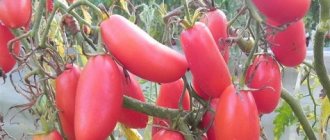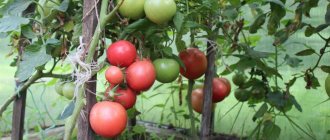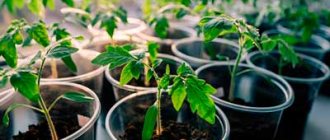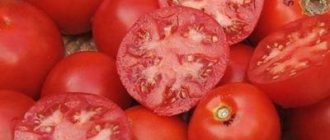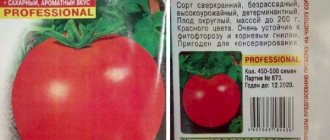Description, characteristics of the Parsley gardener variety with photo
Seeds from the Siberian garden
Tomato Parsley gardener were bred by Altai breeders back in 2004. In 2013, it was included in the State Register of Breeding Achievements in the Russian Federation for cultivation in open ground on private farms.
Manufacturer: Siberian Garden.
The tomato has a medium early ripening. The fruiting period is quite extended - tomatoes can ripen until mid-October.
Parsley gardener is recommended for cultivation in the southern and central regions of Russia. In the northern part of the country, it is preferable to plant this tomato in greenhouses.
- It belongs to the superdeterminate type; when grown in greenhouse conditions, the plant can grow up to 1 m in height.
- When planting a tomato in open ground, its height rarely exceeds 50-60 cm. Fruit ripening begins approximately 110-120 days after planting.
- Tomato bushes are not very large, standard type, and have strong stems.
- The leaves are dark green, medium in size and have the usual shape for tomatoes.
The variety does not require pinching.
- The flower ovary is usually located above each pair of leaves. Each cluster bears 5-7 fruits.
- The weight of the first fruits reaches 200-250 grams (but there are also giants whose weight is more than 300 grams), the subsequent ones grow smaller, their weight is about 150-180 grams.
- Tomatoes have an oval shape, reminiscent of a cap (hence the interesting name).
- Ripe fruits have a bright pink color. Tomatoes have tasty, aromatic and quite sweet pulp. When cut, the sugary structure of the pulp is clearly visible.
- Ripe tomatoes, thanks to their dense and thick skin, have excellent transportability over long distances. Harvested during the period of blanzhe ripeness, the crop ripens very well and can be stored for a long time.
- The tomato is very good for canning - the skin does not crack, and the pulp retains its structure.
- Tolerates dry weather well and can bear fruit with insufficient watering.
Tomato Parsley gardener has good immunity to various diseases, which also include late blight.
Advantages and disadvantages of the variety
photo of Parsley fruits
The Parsley gardener tomato variety has a large number of positive qualities, which include:
- Attractive appearance;
- Wonderful taste;
- Suitable for canning;
- Excellent yield (if the plant is provided with proper care);
- Long fruiting period;
- They have good transportability;
- No need to stepchild;
- The ability to develop well and bear fruit even in dry weather;
- Immunity to many diseases.
But besides the positive aspects of the variety, there are also some disadvantages:
- The plant needs timely and proper care;
- If there is too much moisture, tomatoes will crack.
Features of cultivation and care
The Parsley tomato gardener should be planted in fertile and well-aerated soil. When planting plants in open ground, you should choose a sunny area well protected from drafts.
- Sowing. To obtain seedlings, seeds should be sown no later than two months before the expected date of planting in a permanent place of growth. As a rule, this is the end of winter or the first days of March.
- Temperature conditions. After the seeds hatch, they need to be provided with a constant temperature within 15°C and plenty of lighting (at least 12 hours a day).
- Additional lighting. In cloudy weather, the plants are illuminated with artificial lighting. At the stage of appearance of 2-3 true leaves, the plants must be picked and planted in separate containers.
- Watering. Transplanted plants must be provided with moderate watering, avoiding stagnation of water. The temperature at this stage must be maintained within 20-22°C.
- Feeding. Liquid complex organic fertilizers are applied at the root.
- Hardening. Approximately seven days before the expected date of planting in a permanent place of growth, the seedlings must be taken out into fresh air, starting with a few hours. Over time, it is worth increasing the period of stay on the street to a whole day.
- Transfer. When the seedlings are already two months old, they need to be transplanted into the ground.
As a rule, planting occurs after the tenth of May. I have no more than 6 plants per 1 square meter. m
Formed Parsley bushes with harvest
After planting the seedlings in a permanent place of growth, further care for them should be as follows:
- Water in the evening with warm, preferably settled water. Watering is carried out directly under the root of the plant.
- The grown plant must be tied to a support, since the abundance of fruits can break the bush;
- Water with complex mineral fertilizers;
- Remove weeds in a timely manner;
- Mulching the soil will help retain moisture for a long time;
- Periodically loosen the soil around the plant trunk;
- Carry out preventive control of pests and diseases.
When grown in greenhouse conditions, it is necessary to periodically create drafts to improve the pollination process of flowers.
Hybrid Parsley gardener has a unique feature - it can be grown from cuttings. To do this, take stepsons (you can also take the tops of branches) and place them in water or moist soil for two weeks. With this method, you can constantly increase the number of seedlings.
In order to please yourself with fresh tomatoes in winter, you can plant the bush in a flower pot and place it on the windowsill. It will be necessary to remove all shoots in a timely manner. This way you can always enjoy fresh tomatoes, and by spring you will already have mature plants.
Diseases and pests
Despite the fact that the hybrid is resistant to most diseases, it is susceptible to blossom end rot, fusarium, and cladosporiosis if poorly cared for and in unfavorable weather conditions. If a problem is detected, remove the damaged parts of the bush and treat with special preparations.
In cool summers, preventive treatment against fungal diseases with preparations containing copper will be required. If tomatoes are grown in a greenhouse, it is necessary to ventilate the greenhouse daily.
The moist and warm environment of the greenhouse is favorable for pathogenic organisms, and the flow of air reduces the growth and development of pathogens.
Treatment with special preparations and insecticides, as well as spraying the bushes with folk remedies based on celandine decoctions, garlic and onion infusions, can help with pests.
When working with insecticides, be sure to be careful, follow the instructions and advice written on the packaging, and carry out the treatment before the flowering period begins. To avoid infection with diseases of nightshade crops, crop rotation is used on the site
Tomatoes have not been planted in the same bed for years, you need to change the place of growth, avoid growing after nightshade crops: potatoes, eggplants, peppers. Since plants of the nightshade family are susceptible to certain diseases. You should avoid being near them.
Tomatoes feel good in the garden after cucumbers, zucchini, onions, cabbage, herbs, carrots, beets, legumes, and grain crops.
Disinfecting and fertilizing the soil every year will reduce the likelihood of disease infection and pest proliferation. It is recommended to remove the top layer of soil in the garden bed or greenhouse.
The thickness of the removed layer is 15-20 cm. It is in this layer that insects leave their larvae for the winter, and there may be pathogens on the surface.
The remaining soil is watered with a solution based on copper sulfate or a hot dark crimson solution of potassium permanganate. Digging the soil allows you to control the development of pests. The application of fertilizers containing calcium helps to increase the resistance of tomatoes to blossom end rot.
Reviews from gardeners who planted the gardener parsley variety
ELENA64, Moscow
Thanks to its unique qualities, the Parsley gardener tomato can grow as seedlings on a windowsill for quite a long time. At the same time, it develops perfectly without compromising quality. Therefore, I plant two-month-old seedlings with established tomatoes in a greenhouse in early May. And after about a month the fruits begin to ripen.
Charlie 83
Our parsley gardener was not early in the open ground, but the fruits were quite large. I really liked the taste, the tomatoes were sweet, juicy and meaty. Their color was bright pink, just a sight for sore eyes! I will definitely plant this tomato next year.
Elena, Moscow region
Excellent tomato, tastes sweet and aromatic. It was grown in partial shade, on not very fertile land, but the harvest was high. Periodically fed with complex fertilizer. I liked it both fresh and pickled. I plan to plant next year too.
Irina, Tambov
I have only good impressions from growing this tomato. The seedlings turned out strong, took root well, the bushes were not tall, but very lush. I didn’t pick off the stepsons, so the bushes were thickly covered with ovaries, reminiscent of New Year trees with green and then pink toys.
Evgenia Igorevna
I grew parsley this year for the first time. I liked the structure of its pulp and taste. This tomato is very good in canning. For the sake of such taste, I plan to plant it next year.
Harvesting and processing
Gardeners advise planting the harvest in its entirety.
The harvest usually begins in July. The fruits are collected as they ripen. After harvesting, tomatoes can last for about 1-1.5 weeks without deterioration in appearance or taste.
Gardeners advise planting the harvest whole, or in pieces for the winter. These tomatoes also make delicious sauces and dressings. These tomatoes are very tasty just fresh; they are used to prepare fresh salads and snacks. You can make tomato paste for borscht from the fruits, but it is better not to make tomato juice from them - due to the low juice content, this is impractical.
Important!
Many gardeners complain that after full ripening the fruits crack. As a result, their shelf life is reduced, and such tomatoes cannot be called marketable.
Tomato Parsley gardener - video review
Many gardeners like parsley for its unpretentiousness and resistance to many diseases. Growing the Parsley gardener variety will not take you much effort and time. Growing such a tomato is perfect for busy gardeners who don’t have enough time, but want tasty and large tomatoes.
The tomato does not need special care; it is enough to plant it and promptly fertilize, water and collect the fruits. A little work and knowledge and this tomato will delight you for a long time with its taste, size and aroma.
Diseases and pests
Strong immunity is the highlight of the Parsley Ogorodnik variety; tomatoes rarely become infected and suffer from diseases such as:
- fusarium;
- cladosporiosis;
- spotting.
During a fungal epidemic, late blight is feared and preventive measures are taken. Irrigate the bushes with copper-based preparations - copper sulfate and Bordeaux mixture. In case of severe symptoms – the presence of brown spots, the shoots are treated with “Ridomil Gold” or “Fundazol”.
When infected with septoria or alternaria, use Metaxil.
Expert opinion
Valentina Rareko
Editor-in-Chief of Repka.online. Experienced summer resident and gardener.
The gardener tomato Parsley is liked by everyone who has ever tried to plant this variety. Many farmers note such advantages as stable yields, excellent taste, and high marketability. The fruits make delicious preparations for the winter - assorted dishes, juices, pastes, ketchups.
